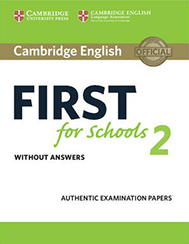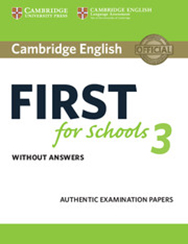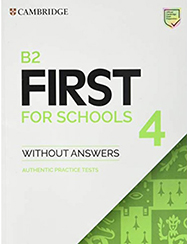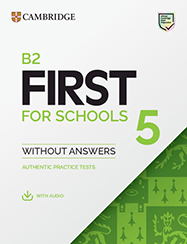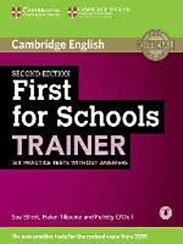B2 First (FCE) for Schools is a Cambridge Assessment English Qualification targeted at upper-intermediate level of the CEFR (B2 level). It is made up of four parts and designed to prove that students can successfully use English language in the real world. B2 First (FCE) for Schools is officially recognized by universities, employers, and governments around the world.
B2 First (FCE) for Schools is an in-depth exam designed by Cambridge Assessment English— an exam board of Cambridge Assessment department of the University of Cambridge, with more than 60 years of experience and expertise in developing and delivering exams to over 5.5 million learners in more than 130 countries.
In 2012, Cambridge Assessment English authorized the Hellenic American Union as one of the official exam centres for B2 First (FCE) for Schools examination in Greece.
Candidates can choose to take B2 First (FCE) for Schools as either paper-based or a digital exam. Similar to the paper-based version, the digital exams are offered at certified test centers across Greece. Although the format of the exams is different, digital exams test the same knowledge and skills as our paper-based exams. In B2 First (FCE) for Schools Digital, candidates use digital tools that allow them to manage the digital environment and perform to the best of their abilities. Both B2 First (FCE) for Schools and B2 First (FCE) for Schools Digital have been developed based on decades of world-leading expertise in language testing for learners.
B2 First (FCE) for Schools is an internationally recognized exam opening doors to several universities, employers and governments around the world as proof of upper-intermediate level on the Common European Framework of Reference (CEFR). B2 First (FCE) for Schools – regardless of whether candidates are examined through the paper-based or digital format – is recognized by the private sector, as well as the Greek state (ASEP/Supreme Council for Civil Personnel Selection), as follows:
|
Level of recognition |
Overall score |
|---|---|
|
C1 |
180-190 |
|
B2 |
160-179 |
|
B1 |
140-159 |
B2 First (FCE) for Schools certificates are valid for life and do not expire. Some institutions, however, such as universities, colleges and employers accept certificates taken recently, usually within 2 to 3 years, to check if candidate’ language skills have been used and maintained. Certificate holders should always check the requirements of the organization of their choice.
Paper 1: Reading And Use of English
Duration: 1 hour 15 minutes
Number of parts: 7 parts
Candidates write their answers in the answer sheet using pencil.
Number of questions: 52 questions in total
Marks: 40% of total
Part 1 (8 questions - 1 mark for each correct answer)
A text in which there are eight missing words or phrases (gaps). Four possible answers for each gap are provided and candidates have to choose the answer that best fits each gap (A, B, C or D).
Part 2 (8 questions - 1 mark for each correct answer)
A text in which there are eight gaps. Candidates have to think of only one word that best fits each gap.
Part 3 (8 questions - 1 mark for each correct answer)
A text in which there are eight gaps. At the end of each line, there is a given word/stem word that needs to be formed correctly to better complete the sentence.
Part 4 (6 questions - up to 2 marks for each correct answer)
Six sentences are given followed by a key word. Candidates have to use the keyword to complete the second sentence so that it has a similar meaning to the first one. For each gap two to five words can be used.
Part 5 (6 questions - up to 2 marks for each correct answer)
A text followed by six multiple-choice questions. Each question has four options (A, B, C or D), and candidates have to decide which is the correct answer.
Part 6 (6 questions - up to 2 marks for each correct answer)
A text with six empty spaces (gaps). After the text, there are some sentences in jumbled order that have been removed from the text. Candidates have to choose the correct sentence for each gap.
Part 7 (10 questions - 1 mark for each correct answer)
Multiple matching questions followed by a single text or several shorter texts. Candidates have to match a given prompt to certain elements of the text(s).
Paper 2: Writing
Duration: 1 hour 20 minutes
Number of parts: 2 parts
Candidates write their answers in the answer booklet using pen.
Marks: 20% of total
Part 1
Candidates are presented with a short prompt and have to write a related essay of 140–190 words using ideas from this prompt. The essay is on a subject of general interest and candidates are expected to express their opinion and support it with reasons.
Part 2
Candidates are asked to write one of the four following questions for part 2: article, email/letter, essay, review or story of 140–190 words. From January 2024, optional set text questions are removed.
Paper 3: Listening
Duration: about 40 minutes, including 5 minutes’ transfer time
Number of parts: 4 parts
Candidates write their answers in the answer sheet using pencil.
Number of questions: 30 questions
Marks: 20% of total (1 mark for each correct answer)
Part 1 (8 questions - 1 mark for each correct answer.)
A series of short, unrelated extracts of approximately 30 seconds each. Candidates have to listen to the extracts and answer one multiple-choice question for each. Each question has three options (A, B or C).
Part 2 (10 questions - 1 mark for each correct answer.)
A monologue lasting approximately 3 to 4 minutes. Candidates have to complete the sentences on the question paper with information they hear on the recording.
Part 3 (5 questions - 1 mark for each correct answer)
Candidates listen to five short related monologues of approximately 30 seconds each. They have to choose which statement from a list of eight best matches what each speaker says.
Part 4 (7 questions - 1 mark for each correct answer)
Candidates listen to an interview or an exchange between two speakers and answer seven multiple-choice questions. Each question has three options (A, B or C). The extract lasts approximately 3 to 4 minutes.
Paper 4: Speaking
Duration: 14 minutes per pair of candidates
Format: 2 examiners -2-3 candidates)
Number of parts: 4 parts
Marks: 20% of total
Part 1
A brief conversation with the examiner who asks candidates about themselves, their past, present and future life plans.
Part 2
Both candidates are given a set of two photographs to talk about.
An individual long turn for each candidate followed by a brief response from the second candidate.
Part 3
A two-way conversation between the candidates who are given instructions with written prompts to be used in a discussion. The discussion involves a decision-making task.
Part 4
A discussion on a few topics related to the above collaborative task.
Paper 1: Reading And Use of English
Duration: 1 hour 15 minutes
Number of parts: 7 parts
Test takers use their keyboard and mouse to select, compose and submit their answers. In the Reading test, test takers can make notes, highlight text and review their answers.
Number of questions: 52 questions in total
Marks: 40% of total
Part 1 (8 questions - 1 mark for each correct answer)
A text in which there are eight missing words or phrases (gaps). Four possible answers for each gap are provided and candidates have to choose the answer that best fits each gap (A, B, C or D).
Part 2 (8 questions - 1 mark for each correct answer)
A text in which there are eight gaps. Candidates have to think of only one word that best fits each gap.
Part 3 (8 questions - 1 mark for each correct answer)
A text in which there are eight gaps. At the end of each line, there is a given word/stem word that needs to be formed correctly to better complete the sentence.
Part 4 (6 questions - up to 2 marks for each correct answer)
Six sentences are given followed by a key word. Candidates have to use the keyword to complete the second sentence so that it has a similar meaning to the first one. For each gap two to five words can be used.
Part 5 (6 questions - up to 2 marks for each correct answer)
A text followed by six multiple-choice questions. Each question has four options (A, B, C or D), and candidates have to decide which is the correct answer.
Part 6 (6 questions - up to 2 marks for each correct answer)
A text with six empty spaces (gaps). After the text, there are some sentences in jumbled order that have been removed from the text. Candidates have to choose the correct sentence for each gap.
Part 7 (10 questions - 1 mark for each correct answer)
Multiple matching questions followed by a single text or several shorter texts. Candidates have to match a given prompt to certain elements of the text(s).
Paper 2: Writing
Duration: 1 hour 20 minutes
Number of parts: 2 parts
Test takers use their keyboard and mouse to select, compose and submit their answers. The Writing test has an automatic word count and they can easily edit their work.
Marks: 20% of total
Part 1
Candidates are presented with a short prompt and have to write a related essay of 140–190 words using ideas from this prompt. The essay is on a subject of general interest and candidates are expected to express their opinion and support it with reasons.
Part 2
Candidates are asked to write one of the four following questions for part 2: article, email/letter, essay, review or story of 140–190 words. From January 2024, optional set text questions are removed.
Paper 3: Listening
Duration: about 40 minutes, including 5 minutes’ transfer time
Number of parts: 4 parts
For the Listening test, headphones with volume control help test takers listen comfortably and concentrate to perform the best of their abilities. Test takers use their mouse to select and submit their answers.
Number of questions: 30 questions
Marks: 20% of total (1 mark for each correct answer)
Part 1 (8 questions - 1 mark for each correct answer.)
A series of short, unrelated extracts of approximately 30 seconds each. Candidates have to listen to the extracts and answer one multiple-choice question for each. Each question has three options (A, B or C).
Part 2 (10 questions - 1 mark for each correct answer.)
A monologue lasting approximately 3 to 4 minutes. Candidates have to complete the sentences on the question paper with information they hear on the recording.
Part 3 (5 questions - 1 mark for each correct answer)
Candidates listen to five short related monologues of approximately 30 seconds each. They have to choose which statement from a list of eight best matches what each speaker says.
Part 4 (7 questions - 1 mark for each correct answer)
Candidates listen to an interview or an exchange between two speakers and answer seven multiple-choice questions. Each question has three options (A, B or C). The extract lasts approximately 3 to 4 minutes.
Paper 4: Speaking
Duration: 14 minutes per pair of candidates
Format: 2 examiners -2-3 candidates)
Number of parts: 4 parts
The Speaking test is face-to-face, to help test takers develop real world communication skills.
Marks: 20% of total
Part 1
A brief conversation with the examiner who asks candidates about themselves, their past, present and future life plans.
Part 2
Both candidates are given a set of two photographs to talk about.
An individual long turn for each candidate followed by a brief response from the second candidate.
Part 3
A two-way conversation between the candidates who are given instructions with written prompts to be used in a discussion. The discussion involves a decision-making task.
Part 4
A discussion on a few topics related to the above collaborative task.
B2 First for Schools results are reported on the Cambridge English Scale. Although the parts are 4, candidates will receive 5 scores on their Statement of Results (Reading, Use of English, Writing, Listening and Speaking) which give them a clear understanding of their performance. These five scores are averaged to give them an overall result for the exam. They will also be given a grade and Common European Framework of Reference for Languages (CEFR) level.
For B2 First for Schools, the following scores will be used to report results:
|
Cambridge English Scale Score |
Grade |
CEFR level |
|
180–190 |
Grade A |
C1 |
|
173–179 |
Grade B |
B2 |
|
160–172 |
Grade C |
B2 |
|
140–159 |
Level B1 |
B1 |
Scores between 122 and 139 are also reported for B2 First for Schools. Candidates will not receive a certificate, but their Cambridge English Scale score will be shown on their Statement of Results. Scores below 122 are not reported, so candidates will not receiver a certificate nor a score for this examination.
The following factsheet can be used as a guide to help teachers and candidates understand how Cambridge English scale works. This information is better applied when using official Cambridge English practice tests.
Register online for your exams through ORFEAS, our online registration system. Find an examination center close to home from a choice of 100 locations throughout Greece and abroad, and complete your application online with your debit, pre-paid or credit card.
You will receive all the details for your upcoming exam via email in a single document that you can save, print and take with you on the day of your test. You will also be sent updates on the status of your application and useful support materials. Expect invitations to webinars for tips and strategies that will help you prepare effectively for the exam.
The ORFEAS registration system does away with print application forms and visits to the bank. Start and complete your registration online in a few simple steps. Use your home computer, tablet or smartphone to apply for your exam.
Results
Please find information regarding the results of the Cambridge University Press & Assessment exams here.
Results and Certificates Services
Discover our available results and certificates services. Learn how you can request, among other things, the rescoring of your test, the notarization of a copy of a certificate, and the issuance of a certification of loss of a certificate.
Find information on the terms and conditions for having one or more sections of your test rescored.
How can I apply?
Use this link to enter the ORFEAS online registration system. From there, follow the steps as suggested. Choose your exam, date and venue and then provide your personal details. In the last step you will be asked to pay with your card of choice. All the information you will need for the day of the exam will arrive in your inbox via email and SMS.
What if I have a question about the procedure?
If you have any questions about the procedure, even as you complete the steps in the process, contact us on 2103680000 for assistance. We have staff available from 9 am - 7 pm on weekdays to help you complete the registration process and answer your questions.
Can I see the status of my registration after I have applied?
Once you complete your registration you will be sent updates on the status of your application. For example, any changes to the date of the examination, if these occur, will be communicated to you via email, SMS or telephone by our support team.
Schedule
| Exam Date: | Exam Administration: | Test Centers: | Registration Period: |
|---|---|---|---|
|
|
|
Registration Period:
|
Support
Find useful information for your exams or existing certifications, tips and advice, free preparation material and more.

